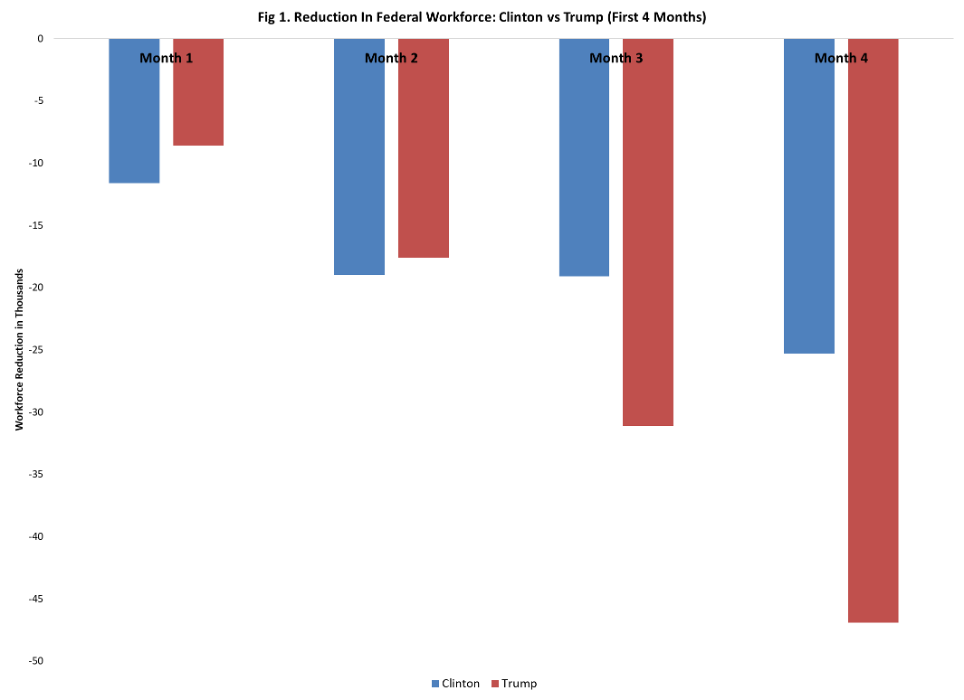Tracking Efforts to Shrink the Size of the Federal Workforce: May 2025 Update
After a busy month in April, May was a quiet month for federal agency layoffs. There are some signs that workforce reduction efforts slowed down in May, with Elon Musk departing the Department of Government Efficiency (DOGE) on May 30. Musk had been a high profile leader in efforts to shrink the size of the federal government. His exit, which has been followed by a souring relationship with President Trump, casts doubt on the pace and direction of these ongoing restructuring initiatives. With his departure, the administration loses both a key strategist and a symbolic force behind the government-wide downsizing efforts.
While May saw limited federal personnel changes, it was a busy month for legal activity. Today’s jobs report marks the fourth Bureau of Labor Statistics (BLS) report to capture at least some of the workforce restructuring and agency-level staffing adjustments initiated after the new administration issued Executive Order (EO) 14210 on “Reforming the Federal Workforce to Better Serve Americans.”
As of May 2025, there were 2.956 million federal government workers, excluding active military personnel. However, 590,200 of those workers were Postal Service employees. Excluding Postal Service workers, there were 2.363 million federal government workers. This is a decline of 15,800 from last month, and a total decline in the federal workforce of 46,800 this year.
Notable Events from the Last Month
On May 9, a federal judge in San Francisco temporarily blocked the administration’s efforts to “restructure and dismantle” the federal government without authorization from Congress. This lawsuit was brought forward by a coalition of nonprofit organizations, labor unions and local governments. The order was set to remain in effect until May 23 and applied to 20 federal agencies, pausing the implementation of existing reduction-in-force (RIF) notices and requesting the release of agency reduction plans.
In response, on May 12, the White House argued in court that releasing agency reduction plans would undermine operations, because the details include plans and strategies for union negotiations, regulatory changes, appropriations requests, and congressional engagement.
On May 13, the Department of Health and Human Services (HHS) reinstated 328 federal employees. The reinstated employees work at the National Institute for Occupational Safety and Health (NIOSH).
During the following week, it was announced that the emails requiring five bullet points summarizing “what you did last week” were being wound down at some federal departments. For example, the Department of Defense (DoD) Undersecretary of Defense for Personnel and Readiness announced that this exercise was coming to an end.
On May 9, San Francisco federal judge Susan Illston put a temporary block on reduction-in-force efforts, and on May 22, a preliminary injunction extended the block. The Justice Department informed the court the following day that it will be asking the U.S. Court of Appeals for the 9th Circuit to review Illston’s decision.
On the Congressional front, the House passed the “Big Beautiful Bill” on May 22. The tax bill would offer federal workers the option of opting into at-will employment in exchange for paying less into retirement funds. At-will federal employees would function more like political appointees, who typically turn over when a new presidential administration takes office.
At the end of the month, the White House began "offboarding" Elon Musk, who had been designated as a "special government employee" allowing him to work a federal job for 130 days each year. Musk has left the Trump administration after helping lead a tumultuous drive to shrink the size of U.S. government and federal workforce.
How Do Ongoing Efforts Compare to Clinton Administration’s Achievements in Shrinking the Federal Workforce?
Reducing the number of federal employees by the same amount that the Clinton administration did during his first term would require shrinking the federal workforce to fewer than 2.08 million workers by 2028. The two figures below show the month-by-month comparison between workforce reductions under the Clinton administration versus current Trump administration, and efforts so far in relation to the ultimate goal of matching the scale of Clinton’s cuts.
To monitor the progress of DOGE’s federal workforce reduction efforts, I had intended to update this tracker series monthly, but if subsequent months continue to be as quiet as the May update, then the series might move to less frequent publications (i.e., quarterly updates). This series covers workforce reductions, agency restructuring efforts, and any new policies or developments related to these initiatives. Stay tuned for regular updates on the Trump administration’s progress toward achieving its federal workforce reduction goals.
You can read my previous updates for February, March, and April here.




